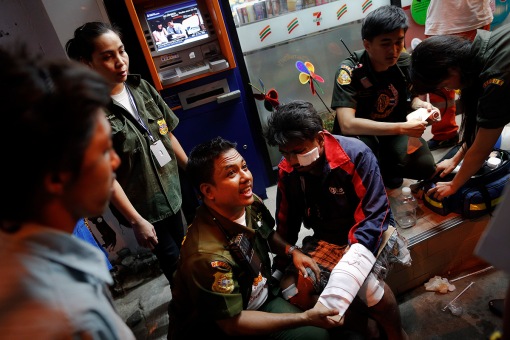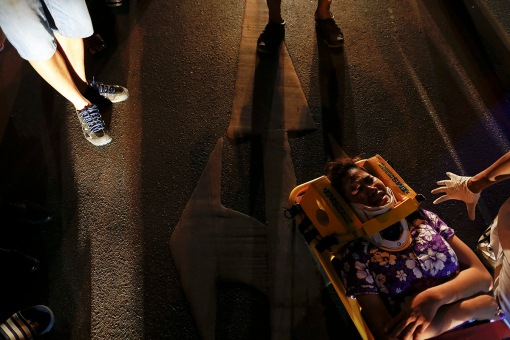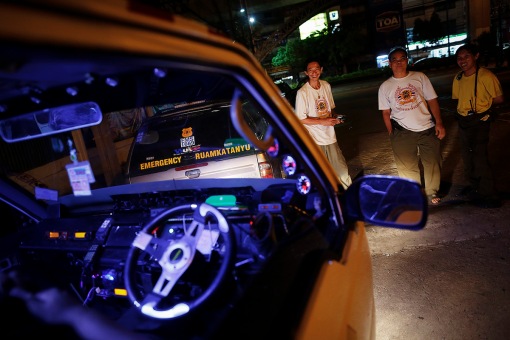Baengnyeong, South Korea

Look at the little blue dot showing a current position on a map: that is the island of Baengnyeong. The map might suggest this outcrop is deep inside North Korea but it’s not. The hand in the picture is mine, the phone with its high-speed internet connection is also mine, and the barbed wire is South Korean.
Baengnyeong – like a few other islands I visited recently – lies on the South’s side of the disputed maritime boundary that separates the two Koreas at sea. Known as the Northern Limit Line, it is an extension of the more famous land border between North and South Korea – the Demilitarized Zone or DMZ – but it curves further to the north. It is the line between two fierce neighbors whose war started over six decades ago and never really ended.
I had seen many pictures of the DMZ but very few of the NLL. The DMZ looks scary but familiar: it is the world’s most heavily armed border, and the only serious boundary remaining from the Cold War.
While recent news from Ukraine suggests that similar borders could soon be drawn elsewhere, the frontier between the Koreas is the real thing: an impenetrable line dividing two different worlds that used to be one.
Life along this border at sea was unknown to me. I had seen only a few news pictures after previous deadly incidents or artillery duels between the Koreas.
There is a famous picture of North Korea’s young leader Kim Jong Un waving from a rickety, overloaded boat as his officers push the vessel into the sea just across from Baengnyeong. Unfortunately this old image was about as much as I would see from the northern side of this maritime border.
But there was no reason why the southern side should remain a mystery. I went out to document life by the boundary, and found it a strange and fascinating mix of modern, high-tech living and old paranoia.

AN OCEAN DIVIDED
When an astronomer watches the stars, patch after patch of black nothingness pass before his lens until he is lucky enough to get a glimpse of, let’s say, a supernova exploding in the distance. Usually, that distance is measured by hundreds of light years, which means he is gazing into the remote past, seeing something that happened a long, long time ago.
On a hill on a South Korean island, overlooking the Northern Limit Line, the feeling is the same. The sea is vast but we were there with our gear at the ready. The thing we were expecting to happen – some sort of interaction between old enemies – was the relic of a very distant past. During many long hours of waiting, nothing really happened. We only saw about a dozen lazy Chinese ships on the North Korean side of the NLL, out fishing.
And then, on a fourth visit the hill on the island of Yeonpyeong, just before we quit our careers as amateur observers for good, a loud siren blasted from behind the beach. At first we thought something was happening on the island, some sort of emergency perhaps, but then two swift patrol boats appeared out of nowhere, speeding towards the Chinese vessels. Following them, a minute later, was a large South Korean corvette – we saw its big guns and soldiers on the deck.
We couldn’t believe it. Ships from the North Korean side had come too close, or even crossed the invisible boundary, and now the South Korean military was chasing them away. For a short moment we thought a real drama was unfolding before our eyes, something we better record as skillfully as possible because it might be breaking news. When we planned the trip, witnessing any sort of interaction between the two sides – be it radio contact, fishermen helping each other out at sea or even petty trade – was at the top of our wish list.
What we didn’t know, and what an experienced coast guard officer explained to us later that afternoon – his voice laced with irony – was that we had gotten overexcited. In fact, such incidents are not really incidents; they happen almost every week. The South Korean military is always ready to protect its borders, and whenever it decides ships from the other side have come too close it simply chases them away.
Nevertheless, we got our supernova and a dose of adrenaline. It was a timely reminder that we were indeed deep inside “enemy territory” and that the situation could escalate at any moment.
A scene from the Cold War had played out before our eyes. Not many places in the world can offer you the chance to gaze into the past from a tourist observation point.

OLD BORDERS, OLD FEELINGS
Working by the NLL is no smooth trip through time. Sometimes it feels like the machine malfunctions, and you are left in limbo between a faded past and a colorful and futuristic present.
This is, thanks for asking, a challenge for any photographer like me trying to put together a coherent sequence of pictures, without giving the impression that I have mixed up two different series of images.
Looking north through razor wire on Yeonpyeong showed me a scene like so many others I have witnessed during my professional life: heavily armed borders, the presence of “us and them”, threats and obvious suffering … It seemed as if some outside force – some photo-shopper in the sky, perhaps – had dimmed all the colors.
But I felt comfortable, I know this situation so well. I like it and I hate it. As I framed my shot, I was almost tempted to capture the scene in a way that would deprive it of life even further, adding more salt to the wound.
But that was just for one short and depressing moment. We listened to a North Korean radio station (the signal is not jammed here, as it is in Seoul) and we almost took pleasure in the sounds we could hear, broadcast from not all that far away. The voice of a news anchor announced that the supreme leader visited another factory and gave famous “on the spot instructions” followed by revolutionary songs from what should be history. We enjoyed hearing it, in a bizarre and almost shameful way.
My relationship with totalitarianism and communism is a weird mixture of well-known painful fact and nostalgia about my late homeland Yugoslavia, my years during Perestroika in the Soviet Union and some wonderful moments I spent in Iran.
But when I witness these societies, I am often the privileged one looking at them from outside. The feeling I have here is the feeling of the reporter with a return ticket in his back pocket, who has covered disasters and wars, but can walk away any time.

MAMA KIM
If there is a female version of Chuck Norris, she can’t be even remotely as tough as Kim Ho-soon, a 66-year-old diver and fisherwoman I had the honor to meet on Baengnyeong.
Originally from the island of Jeju, where female pearl divers are not uncommon, at first sight this utterly lovable woman could be mistaken for any other elderly citizen of South Korea. Except she doesn’t spend her days enjoying long walks, gossiping or watching soap operas on TV, like most of her generation. She dives for seafood almost every day, and has done so since she was nine.
I asked her why she is still doing this now and she immediately answered: “Because I’m best at this,” as if her age counted for nothing in the cold winter waters of the Yellow Sea.
“North Korea doesn’t bother us… [South Korean] military, China and reporters are ones that bother us,” she added, while waiting one foggy morning for the military’s permission to take her three-strong crew diving and fishing.
Fishermen from Baengnyeong can’t go when and where they want and that makes them visibly unhappy. Every port on the island has a wooden booth with a young marine inside and a mast above it.
On the mast is a flag whose color Kim Ho-soon – also known as mama – checks every morning. If it’s red, that means the sea is a no-go; blue means go; and yellow is the sign of a frustrating stand-by. Often, the poor soldier manning the booth feels the heat from fishermen for flying a red or yellow flag. The messenger always pays the price.
It all makes sense, the flags and the tough behavior with fishermen. If they stray too close to the NLL, someone from the other side might snatch them, despite the constant patrols by South Korean marines. It’s the price you pay for living on such an isolated island so close to the enemy.
Soon, a blue flag fluttered on the mast, and the mama happily took us on a little boat steered by her son-in-law. As I put on another layer of clothes in an effort to stop the unstoppable wind that was blowing in from the open sea, the old lady was getting ready for a dive. Her kit: a simple mask, a knife and a bag that she fills with seafood by hand (she can bring back 40 kilograms in one go).
Soon after, she disappeared into the depths and just a tiny yellow air hose remained visible from the surface. In the background, a military corvette sailed by, marking the end of Kim Ho-soon’s world. What we don’t see behind it, dissolved in fog, is North Korea.

ONLY BEAUTIFUL, PLEASE
In North Korea, just across the invisible border and not too far from a ferry carrying three sleeping South Korean marines, rules for taking pictures are simple: only beautiful, please (to quote the title of the book by John Everard, former British ambassador to Pyongyang).
And that is only if the person with the camera is lucky enough to visit a country so many want to leave.
Journalists play a funny game – most of the time we really want to go to places that others really want to leave.
Whether in North Korea, Fukushima or Sarajevo reporters are always headed in the opposite direction, against the current and often against common sense.
North Korea probably tops the list of photographers’ dream destinations. I haven’t met anyone in this profession who doesn’t want to go there. I’ve been asked more questions by colleagues about how I once made it to Pyongyang than about anything else I’ve done in my career.
Ironically, the images we see from the North are not unlike what you remember in the morning after awaking from a nightmare: just flashes, a few details, maybe a single scene around which we knit our pain and anxiety.
The pictures in between soon vanish, or become an “only beautiful, please” image, a boring commonplace, like the images of thousands cheering for the Leader, or a pretty policewoman in white socks directing traffic in Pyongyang.
South Korea has its own “only beautiful, please” aesthetic, but it’s fundamentally different. The truth is that I have rarely been anywhere where I have been ignored or snubbed so much as on the South Korean islands near the NLL.
More often than not, people looked away or soldiers comically turned on their heels and marched in the opposite direction when I lifted my camera. At first I thought it was just bad luck. Soon I realized their photo shyness was widespread, or instructed.
It seemed like soldiers were told to turn away from a stranger’s camera if the situation was not pre-arranged; a friend who knows a lot about the subject told me they have to look beautiful and strong all the time.
I have taken many images of tough-looking soldiers, but then an important and differently beautiful frame sometimes comes along – like the one of sleeping soldiers, shown above – and offers a new perspective.
At the same time, freedoms on opposite sides of the Korean border are fundamentally different – not to be compared.
On the South side I move freely. Nobody really stops me, even if I get close to the border fence or climb the hill on which a terrifying rocket is planted. To my great delight, there is no need for any special permission; there are no unpassable checkpoints and almost no photo restrictions.
Here, I actually have a good chance to see and photograph real life as it is – both the “only beautiful, please” and beyond.
Some more pictures from island near NLL here.









































